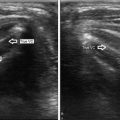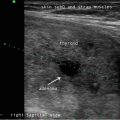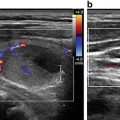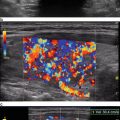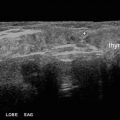Diagnostic category
ROM(%)a [6]
Nondiagnostic or unsatisfactory
1–4
11–26
Benign
0–3
4–9
Atypia of undetermined significance or follicular lesion of undetermined significance
~5–15
19–38
Follicular neoplasm or suspicious for a follicular neoplasm
15–30
26–40
Suspicious for malignancy
60–75
50–79
Malignant
97–99
98–99
The brief description of the diagnostic categories in the Bethesda Classification is as follows:
- 1.
Nondiagnostic or Unsatisfactory:
- (a)
This diagnostic category applies to specimen which are nondiagnostic due to limited cellularity, no follicular cells and adequate specimen which are uninterpretable due to poor fixation and preservation, i.e., obliteration of cellular details.
- (b)
In some cases of solid nodules it may be prudent to process and examine the entire specimen.
- (a)
- 2.
Benign:
- (a)
The diagnostic terms in this category include but are not limited to nodular goiter, hyperplastic/adenomatoid nodule in goiter, chronic lymphocytic thyroiditis, and sub-acute thyroiditis.
- (b)
A thyroid nodule with a benign diagnosis should be followed periodically by US examination; a repeat FNA may be considered if the nodule increases in size (as per thyroid nodule management guidelines).
- (a)
- 3.
Atypia of undetermined significance/Follicular lesion of undetermined significance (AUS/FLUS):
- (a)
- (b)
It is recommended that the number of cases diagnosed as such should be kept to minimum; 7 % of the total diagnoses.
- (c)
- (d)
Molecular studies with high negative and positive predictive value are recommended in cases diagnosed as AUS/FLUS .
- (a)
- 4.
Follicular/Follicular neoplasm with oncocytic features (AKA Hurthle cell) neoplasm or Suspicious for Follicular or Follicular neoplasm with oncocytic features (AKA Hurthle cell) neoplasm:
- (a)
These diagnostic terms encompasses both benign and malignant tumors, i.e., follicular adenoma and carcinoma and oncocytic follicular adenoma and carcinoma. The cytologic diagnosis of “neoplasm” reflects the limitations of thyroid cytology , since the diagnosis of follicular carcinoma is only based on the demonstration of capsular and/or vascular invasion. Several authors have shown that, at most, only 20–30 % of cases diagnosed as “follicular neoplasm ” are diagnosed as malignant on histological examination and the rest are either follicular adenomas or cellular adenomatoid nodules, i.e., benign [11].
- (b)
Several studies have shown that half or more of the malignant cases diagnosed as follicular neoplasm or suspicious for follicular neoplasm (FON/SFON) are found to be either invasive follicular variant of papillary thyroid carcinoma (FVPC) and noninvasive FVPC (also known as noninvasive follicular tumor with papillary like nuclear features—NIFTP) on surgical excision [11, 14, 15].
- (a)
- 5.
Suspicious for malignancy:
- (a)
This term includes suspicious for: papillary carcinoma , medullary carcinoma, other malignancies, lymphoma (flow cytometry can be recommended with repeat FNA), metastatic carcinoma/secondary tumor, and carcinoma (includes poorly differentiated and anaplastic carcinoma ).
- (a)
- 6.
Malignant:
- (a)
The thyroid FNA cases diagnosed as such carry a 97–100 % risk of malignancy . The malignant tumors of the thyroid diagnosed on FNA include: papillary carcinoma and variants, medullary carcinoma, poorly differentiated carcinoma, anaplastic carcinoma, metastatic carcinoma (with immunohistochemistry), and lymphoma (combined with flow cytometry ).
- (a)
30.2 Cytomorphology of Thyroid Lesions
30.2.1 Benign Lesions
30.2.1.1 Nodular Goiter
The term goiter encompasses both nodular and diffuse enlargement of the thyroid, and clinically can be divided into toxic and nontoxic variants based on the clinical symptoms and thyroid function tests (hypothyroid, euthyroid, or hyperthyroid) and isotope uptake on scintigraphy [16, 17].
The cytology specimen from a benign nodule shows (depending upon the preparation method) abundant watery colloid, small, round to oval shaped follicular cells with scant cytoplasm (may contain small blue lysosome granules) and dark nuclei arranged in monolayer sheets, groups with follicle formation or as single cells [18] (Fig. 30.1). Macrophages are usually present and their number depends upon the presence or absence of degenerative changes or a cystic component [18, 19]. The aspirates from a hyperplastic/adenomatoid nodule tend to be more cellular and contain an admixture of follicular cells and oncocytic cells arranged in monolayer sheets in a background of watery colloid and macrophages [18–20].
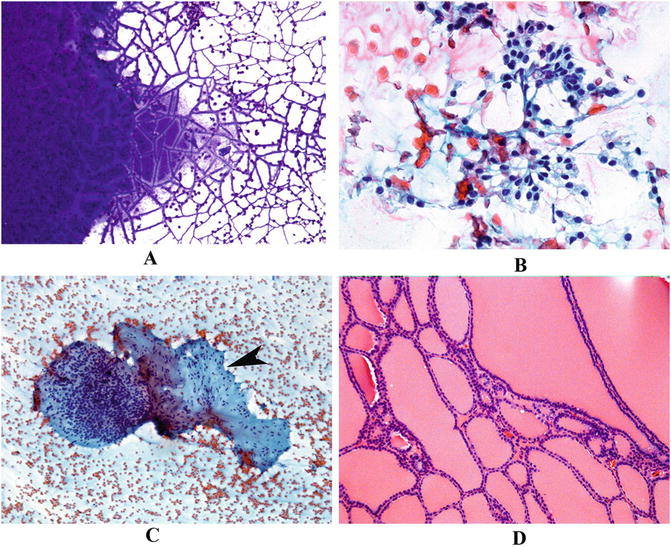

Fig. 30.1
A case of nodular goiter demonstrating back watery colloid—onsite air-dried smear (“chicken wire appearance”) (a—Diff Quik® stain). The alcohol-fixed smear from the same case demonstrates follicular cells with small round nuclei arranged in flat sheets (b—Papanicolaou stain) and cohesive clusters with associated stroma (arrowhead) (c—Papanicolaou stain). The histology of nodular goiter demonstrates macrofollicles filled with watery colloid (d)
Solitary papillary hyperplastic nodules frequently occur in children and teenagers and can be hyper-functioning on radionuclide scan. By histologic examination these lesions are encapsulated and often demonstrate cystic change, papillary architecture and the lesional cells lack nuclear cytology of papillary thyroid carcinoma [21, 22]. The FNA specimens of solitary papillary hyperplastic nodules tend to be cellular and show papillary clusters, nuclear atypia and pleomorphism, nuclear grooves, multinucleated giant cells, and cells with vacuolated cytoplasm. In view of these features, some of these cases could be misclassified as “suspicious of” or consistent with papillary carcinoma [23].
30.2.2 Diffuse Toxic Goiter (Graves’ disease)
Patients with Graves’ disease (GD) usually do not undergo FNA; however, cytology material may be obtained from a hypo-functioning or enlarging nodule arising in a background of GD. These specimens are usually cellular, show features similar to hyperplastic goiter, and may contain lymphocytes and oncocytic cells [24–27].
30.2.3 Autoimmune Thyroiditis/Chronic Lymphocytic Thyroiditis
FNA is usually performed in patients with chronic lymphocytic thyroiditis who present with distinct nodules. The specimens usually show scant colloid, oncocytes (Hürthle), follicular cells, lymphocytes, and a few plasma cells. The lymphocytes are usually seen in the background, interspersed among cell groups and in some cases one may see an intact lymphoid follicle (Fig. 30.2) [28]. The oncocytic follicular (Hürthle) cells may display nuclear atypia and similarly follicular cells may show some chromatin clearing and intranuclear grooves; however, one should refrain from interpreting these changes as malignant [29, 30]. Papillary thyroid carcinoma (PTC) arising in the background of thyroiditis often seen as a separate population of tumor cells, devoid of a lymphocytic infiltrate and with diagnostic nuclear features [22].
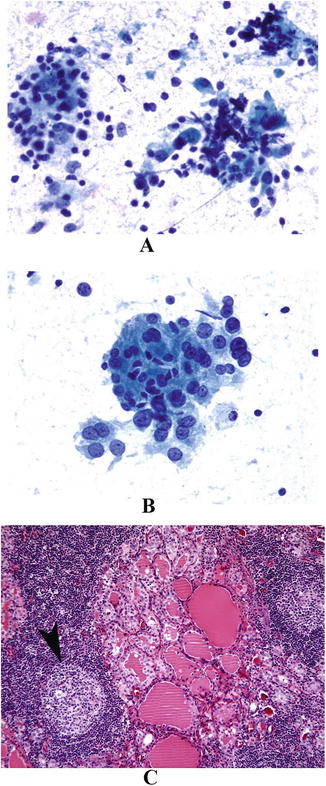

Fig. 30.2
A case of chronic lymphocytic thyroiditis on low power showing cells and lymphocytes in background and among oncocytic follicular cells (a—alcohol-fixed smear, Papanicolaou stain). On high power the cells are oncocytic follicular cells showing dense cytoplasm and round nuclei (b—alcohol-fixed smear, Papanicolaou stain). The histology of chronic lymphocytic thyroiditis is evident by oncocytic follicular nodules surrounded by lymphocytes and some areas show “lymphoid germinal center formation” (arrowhead) (c—hematoxylin and eosin stain)
30.2.4 Follicular Neoplasm/Suspicious for Follicular Neoplasm
Thyroid (FNA) cannot distinguish between benign and malignant follicular patterned lesions, i.e., follicular adenoma and carcinoma [33], because the diagnosis of follicular carcinoma is based on the demonstration of capsular and/or vascular invasion [34–36]. Several authors have shown that, at most, 20–30 % of cases diagnosed as “follicular neoplasm ” are diagnosed as malignant on histological examination and the rest are either follicular adenomas or cellular adenomatoid nodules, i.e., benign [37, 38]. Interestingly half of the malignant cases are diagnosed as follicular variant of papillary thyroid carcinoma. However, this rate of malignancy will dramatically change in the future due to reclassification of noninvasive follicular variant of PTC as noninvasive follicular tumor with papillary like nuclei—NIFTP [39].
The FNA specimen of a follicular neoplasm is usually hyper-cellular and shows a monotonous population of follicular cells. The watery colloid seen in the aspirates of nodular goiter is usually lacking. The colloid in the aspirates of follicular neoplasm appears as round dense eosinophilic deposits on Romanowsky stain with or without surrounding cells [33, 40]. The lesional cells can be seen as three dimensional groups or microfollicles with prominent nuclear overlapping and crowding [36, 40] (Fig. 30.3).
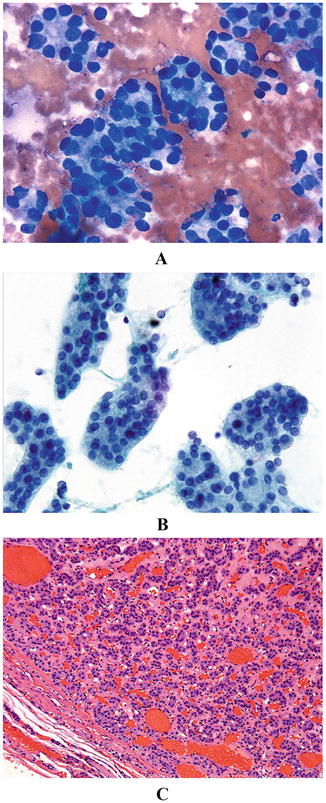

Fig. 30.3
A case diagnosed as follicular neoplasm/suspicious for follicular neoplasm demonstrating a monotonous population of follicular cells arranged in follicular patterned groups—onsite air-dried smear (a—Diff Quik® stain). The alcohol-fixed smear stained with Papanicolaou stain shows round nuclei lacking nuclear features of papillary carcinoma (b). On surgical excision this case showed an encapsulated follicular patterned nodule without any evidence of invasive characteristics; diagnosed as follicular adenoma (c—hematoxylin and eosin stain)
30.2.5 Oncocytic Follicular (AKA Hürthle Cell) Neoplasm/Suspicious for Oncocytic Follicular (AKA Hürthle Cell) Neoplasm
The Oncocytic cells (oxyphil, Askanazy cells, Hürthle cells) are usually larger than follicular cells and have distinct cell borders, voluminous granular eosinophilic cytoplasm, and an eccentrically or centrally placed round nuclei with a prominent nucleolus. A majority of oncocytic follicular/Hürthle cell neoplasms of the thyroid are solitary mass lesions that show complete or partial encapsulation. Oncocytic follicular neoplasms are defined as being composed of at least 75 % oncocytic cells. These can be divided into adenoma and carcinoma based on the same pathologic criteria as applied in the diagnosis of follicular carcinoma, i.e., the identification of capsular and/or vascular invasion [41, 42].
FNA specimens obtained from an oncocytic follicular neoplasm usually demonstrate a monotonous population of oncocytic cells arranged in cohesive groups/tissue fragments and as single cells [43, 44]. Neoplastic oncocytic follicular cells, i.e., obtained from either adenoma or carcinoma are usually large and round to oval or polygonal in shape with well-defined cell borders [34, 45]. Random nuclear atypia is commonly observed in oncocytic follicular lesions ; this can be seen in the form of nuclear enlargement, multi-nucleation, cellular pleomorphism and prominent “cherry red” nucleoli. Intranuclear grooves are common in non-papillary oncocytic follicular lesions, however, the nuclei maintain a round shape with prominent nucleoli and other major diagnostic features of papillary carcinoma are not seen [46–48]
The FNA specimens of oncocytic neoplasms usually contain thick colloid that appears as circular deposits representing the lumen of thyroid follicles. It should be noted that similar atypical nuclear features can also be seen in aspirates of nonneoplastic oncocytic lesion seen in long-standing goiter, toxic nodular goiter, and chronic lymphocytic thyroiditis.
The differential diagnosis of oncocytic follicular neoplasm includes other tumors of the thyroid gland with oncocytic cytoplasm. These include: variants of papillary thyroid carcinoma such as oncocytic variant, Warthin–like variant and tall cell variant of papillary carcinoma; oncocytic variant of medullary thyroid carcinoma and granular cell tumor of the thyroid. An occasional intra–thyroidal oncocytic parathyroid adenoma can also mimic an oncocytic follicular neoplasm .
30.2.6 Malignant Neoplasms
30.2.6.1 Papillary Thyroid Carcinoma and Its Variants
Papillary thyroid carcinoma (PTC) is the most common form of thyroid malignancy in non-endemic goiter regions. The classic variant of papillary carcinoma predominantly consists of true papillae, i.e., finger like projection with cores containing vessel(s) and connective tissue surrounded by tumor cells. The papillae are of different sizes and can display a complex branching pattern. It is not uncommon to encounter a few follicles intermixed with papillae in this variant of PTC. Minor cystic changes are common. By light microscopy, the tumor cells are larger and are cuboidal to short columnar and contain amphophilic to slightly eosinophilic cytoplasm. Nuclei are relatively large and oval in shape and show nuclear indentations/grooves and round intranuclear cytoplasmic pseudoinclusions. Nucleoli are usually small and situated close to the nuclear membranes (eccentric), and much of the interior of the nucleus to be “empty,” “clear,” or “ground glass” in appearance. Follicles may be colloid-filled or empty and occur as small or large follicles , i.e., micro- or macro-follicles [49].
The cytology diagnosis of PTC is based on major and minor cytologic criteria. The major diagnostic feature is the characteristic nuclear morphology regardless of cytoplasmic features and architecture. The FNA specimen of PTC is usually cellular and shows tumor cells arranged in papillary groups, three-dimensional clusters or as single cells in a background of watery or thick “ropy” colloid (i.e., chewing gum colloid), nuclear or calcific debris, macrophages and stromal fragments. The cell groups may show a typical concentric arrangement of lesional cells described as “cellular swirls” [5, 50].
The individual tumor cells are enlarged, elongated, i.e., oval in shape with eosinophilic cytoplasm (cytoplasmic eosinophilia is common in Romanowsky stained preparations but is usually indistinct in alcohol-fixed Papanicolaou stained preparations; this also holds true for monolayer preparations). The nuclei show elongation, membrane thickening, chromatin clearing, grooves, and inclusions. The nucleoli are usually small and eccentric. Intranuclear grooves and inclusions can be seen in other benign and malignant conditions of the thyroid (Fig. 30.4). These include Hashimoto’s thyroiditis , nodular goiter , hyalinizing trabecular neoplasm , oncocytic follicular tumors , and medullary carcinoma [22, 51].
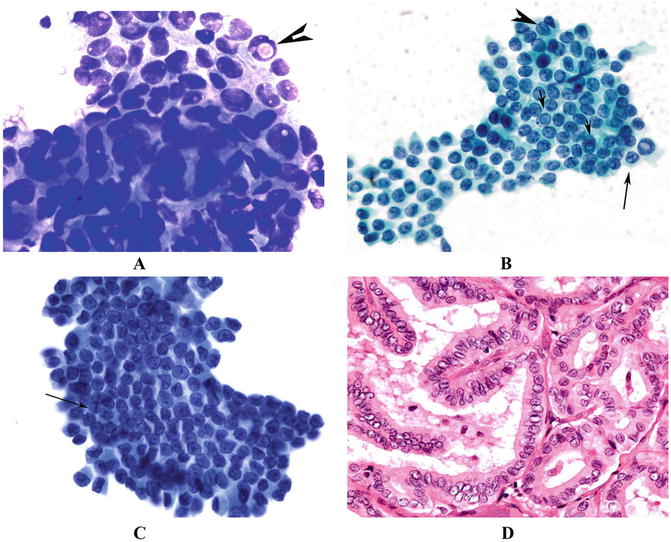

Fig. 30.4
A case of classic variant of papillary thyroid carcinoma showing lesional cells with arranged in papillary configuration demonstrating a single intranuclear inclusion—onsite air-dried smear (arrowhead) (a—Diff Quik® stain). The tumor cells demonstrate enlarged oval nuclei intranuclear grooves (arrowhead), eccentric nucleoli and intranuclear inclusions (arrows) (b—Papanicolaou stain). The ThinPrep® slide shows tumor cells arranged similar to a “Jigsaw Puzzle” with intranuclear grooves (arrow) (c). The histology demonstrates well formed papillae with vascular core lined by cells with nuclear features of papillary carcinoma (d—hematoxylin and eosin stain)
Psammoma bodies occur in about 20 % of cases of papillary thyroid carcinoma. These are lamellated round to oval calcified structures that represent the “ghosts” of dead papillae. Multinucleated histiocytes are common in FNA specimens of papillary thyroid carcinoma [52, 53]. The cytologic features of papillary thyroid carcinoma may not be readily evident in monolayer preparations [54].
The follicular variant of papillary thyroid carcinoma (FVPTC) is the second most common variant of PTC. Its diagnosis may be made when more than 70 % of the tumor consists of neoplastic follicles lined by cells demonstrating diagnostic nuclear morphology of PTC. Three distinct types of follicular variant exist represented by: the infiltrative type, the diffuse follicular variant, and the encapsulated follicular variant. The encapsulated FVPTC is characterized by the presence of a capsule around the lesion and is associated with an excellent prognosis. In some cases the diagnosis of this particular variant of papillary carcinoma can be difficult due to the presence of multifocal rather than a diffuse distribution of nuclear features of papillary thyroid carcinoma . Because of this peculiar morphologic presentation, these tumors can be misdiagnosed as adenomatoid nodule or follicular adenoma. Due to their excellent prognosis, the noninvasive forms of FVPTC are now recommended to be designated as noninvasive follicular tumor with papillary like nuclei—NIFTP, i.e., neoplasms but not carcinomas [39].
The cytologic interpretation of FVPTC can be challenging due to a paucity of diagnostic nuclear features [55]. The cytologic samples from FVPTC usually show enlarged follicular cells arranged in monolayer sheets and follicular groups in a background of thin and thick colloid. The individual tumor cells show nuclear elongation, chromatin clearing and thick nuclear membranes. The intranuclear grooves in FVPTC are delicate and do not traverse the entire length of nucleus; however, nuclear grooves and inclusions are very scarce. Thus, a majority of cytologic samples of FVPTC are diagnosed as either follicular neoplasm or suspicious for papillary carcinoma [56, 57].
Cystic papillary thyroid carcinomas are often encapsulated and the cystic component usually ranges from 50 % to occupying most of the lesion. The papillary fronds lining the cyst wall may be visible on gross examination. FNA specimens of this tumor contain large numbers of hemosiderin-laden histiocytes and considerable cellular debris. Sheets of intact follicular cells may be seen, which resemble those from cellular adenomatoid nodules; however, these will demonstrate nuclear cytology suspicious or diagnostic of PTC. Squamous metaplasia has been reported in cases of cystic PTCs. Dense globules of pink-staining colloid may be present [58–60].
Tall cell variant of papillary thyroid carcinoma is an aggressive form of PTC and can lead to multiple local recurrences, distant metastases and even death. This tumor shows oncocytic cells which are at least three times as tall as their width [61]. The cytologic samples from this tumor contain elongated cells with sharp cytoplasmic borders, granular eosinophilic cytoplasm, and variably sized nuclei with nuclear features of papillary carcinoma [62, 63]. The diagnostic nuclear features of PTC are readily found in aspirates of this variant. The intranuclear inclusions can be multiple within the same nucleus giving rise to a “soap-bubble-like” appearance [63].
30.2.7 Diffuse Sclerosis Variant of PTC
The diffuse sclerosis variant of papillary thyroid carcinoma (DSV-PTC) is rare, representing only approximately 3 % of all papillary carcinomas. The tumor, which most often affects children and young adults, may present as a bilateral goiter. In histologic section, the tumor cells permeate the gland outlining the intra-glandular lymphatics. Tumor papillae have associated areas of squamous metaplasia. Numerous psammoma bodies are found; lymphocytic infiltrates are also found around the tumor foci. This particular feature gives rise to a “snow storm” appearance on ultrasound examination. Cytological preparations shows tumor cells with nuclear features of papillary carcinoma arranged in nests and numerous psammoma bodies. Some cases may also demonstrate a brisk lymphocytic infiltrate around the tumor cell groups and in the background. Squamous metaplasia is commonly seen in aspirates of DSV-PTC [64–66].
The cytologic features of less common variants of PTC such as Warthin–like variant, columnar cell variant, clear cell variant, and others have been described in the [64, 67, 68].
Stay updated, free articles. Join our Telegram channel

Full access? Get Clinical Tree



